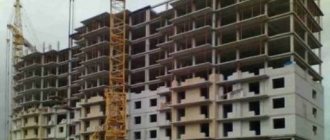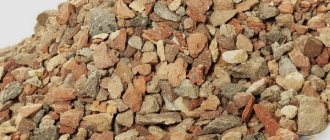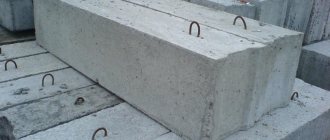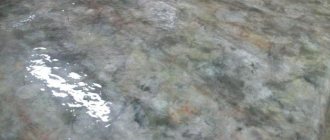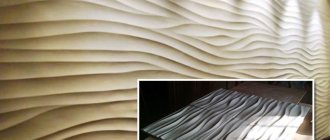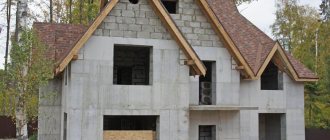Reinforced concrete is a composite material, that is, consisting of several elements. Therefore, the methods of its manufacture depend on the type of material: prefabricated - ready-made blocks are assembled into a single unit on site, monolithic - concrete is poured into the formwork already on site, and precast-monolithic, combining the advantages of both technologies. So, what is the technology for producing reinforced concrete, and how does it differ from the production of other types of concrete?
Reinforcement
Reinforced concrete structures, which mainly work in bending, are made using reinforcement. Reinforcing products (frames, meshes, embedded parts, mounting loops) are produced in a separate workshop.
The reinforcement structure is placed in the form lubricated and prepared for concreting. To create a technological gap between the concrete surface and the reinforcing bars, clamps of different sizes are used. This measure prevents contact between the reinforcement and the mold. If the product involves the use of embedded parts, then they are fixed before molding. Mounting loops are also installed in advance, and fastening is carried out with knitting wire.
Features of manufacturing concrete products
Finished structure removed from mold
The instructions for manufacturing reinforced concrete products are determined by the basic properties of production materials. Cement-containing mortars are liquid or semi-liquid, and therefore the main technological feature of the production process is their pouring into special molds.
Essentially, the production technology involves installing a reinforcing frame in the mold cavity with your own hands and then pouring the solution. As the solution dries, the finished product gains the required strength. At the end of this process, the finished product is removed from the mold and can be used for its intended purpose.
The manufacturing technology of reinforced concrete and prefabricated concrete products includes a list of individual operations that make up the production process. All operations carried out during the production of reinforced concrete products are conventionally divided into main, auxiliary and transport.
Unloading finished structures from molds
Conventionally, the technological process can be divided into the following sequentially implemented stages:
- concrete preparation;
- production of reinforcement and frame production;
- reinforcement of concrete products;
- molding concrete mixture;
- temperature and humidity treatment of the product;
- decorative finishing of the front surface.
Important: When producing external wall panels, concrete structures may be subject to additional modifications. Thermal insulation materials can be placed in the panels, both during molding and at the stage of assembly of individual product shells.
Production equipment
The photo shows formwork for making floor slabs
The equipment used in the production of reinforced concrete products, in accordance with its purpose, is divided into technological - main, as well as auxiliary and transport. Equipment for the production of reinforced concrete products involved in a single production complex is called a production line.
In the production of reinforced concrete products, special forms are used, which can be made of metal, reinforced concrete, or lumber of wood origin. Combined forms are also used, built using several different materials.
The photo shows the use of a vibropress during concrete compaction
Regardless of the type of materials used, the finished forms must meet the following requirements:
- accuracy of ensuring the established standard sizes and configurations of products upon completion of all technological operations;
- rational design and, as a result, low weight of the mold in relation to the weight of the finished product;
- lack of labor intensity and ease of assembly and disassembly;
- structural rigidity when pouring concrete with different densities and specific gravity.
Important: The effectiveness of using production forms is largely determined by the correct choice of lubricants. A properly selected lubricant prevents the solution from sticking to the inner surface of the formwork, thereby contributing to the durability of the form and improving the quality of the manufactured concrete products.
Current schemes for industrial production of reinforced concrete products
Thermoelectroforms with the finished product
In accordance with the methodology for implementing the molding process, three main schemes for the manufacture of reinforced concrete products can be distinguished:
- Production in non-movable forms involves carrying out all technological operations, starting with preparation and ending with dismantling the formwork in one place. An example of the implementation of such a scheme is the molding of reinforced concrete products in matrices, in cassettes or on flat stands.
- Production in movable molds involves the step-by-step transportation of formwork with poured mortar from one production station to another. This production scheme applies to the in-line aggregate and conveyor molding method.
- Continuous molding is a relatively new production process that is characterized by efficiency, high productivity and relatively low energy consumption. The method is carried out using a vibratory rolling mill.
Concrete reinforcement
Filling formwork with concrete with reinforced mesh
Regardless of what equipment is used for the production of reinforced concrete products, the most important technological stage is the reinforcement of the mixture. And this is not surprising, since the method of implementing the reinforcement of mortars determines such parameters of the finished structure as the strength and cost of reinforced concrete products.
Important: According to statistics, the price of a finished reinforced concrete product depends 20-30% on the cost of the reinforcement. Therefore, the approach to developing the features of reinforcement of reinforced concrete structures is important both technically and economically.
In the photo - frames for casting piles
Reinforcement of mortars in the production of reinforced concrete products is of two types: prestressed and ordinary - unstressed.
Let us consider in more detail the features of the implementation of each of these methods, since the strength qualities of the finished products largely depend on them.
- Non-stressed reinforcement of reinforced concrete products is carried out both using a spatial frame and using flat meshes made from wire rod or steel rods with the appropriate cross-sectional diameter.
Frames, during such reinforcement, can only be manufactured using the welded method. Unstressed reinforcement is divided into main (working) and auxiliary (installation).
The main reinforcement is placed in areas experiencing maximum tensile stress. Auxiliary reinforcement, on the contrary, is used in those areas of reinforced concrete products where there is no tensile stress or, on the contrary, compression is present.
- Stressed reinforcement of reinforced concrete involves the creation of preliminary compression, both in the area of tensile stresses and throughout the entire section of reinforced concrete products. For example, in the manufacture of foundation blocks or piles, the pre-compression parameters are up to 60 kg/cm². Compression is performed by tensioning the reinforcement for a certain time.
Molding
The concrete mixture is supplied to the forming site by concrete spreaders, which are filled with material in the concrete mixing department. If the technology for the production of concrete products does not provide for such equipment, then the mold is filled with the mixture from a hopper, which is transported by an overhead or gantry crane.
During the concreting process, a workshop worker helps with shovels to evenly distribute the concrete over the form. The supply flow should not cause displacement of the reinforcement. After the mixture is distributed, vibration is performed. Large manufacturing enterprises use vibrating platforms, while small organizations use deep vibrators.
Some metal molds are equipped with stationary vibrators, which significantly reduces factory labor costs. The duration of vibration must be normalized, otherwise an excess of the process will lead to delamination of the mixture, and therefore to deterioration of the structure. As soon as cement laitance appears on the surface of the concrete, the vibration stops. The molder smoothes the surface with a trowel and aligns the mounting loops, which can tilt due to vibration.
Cassette production
Cassette production is widely used in the production of solid floor panels and interior walls, partitions of industrial buildings, flights of stairs, ventilation units, etc. Molding of products is carried out in two- and multiple-place forms of periodic action, including with void formers, and in continuous cassettes (cassette-conveyor production method). The concrete mixture is compacted using external and deep vibration exciters. Heat treatment is carried out on site due to the circulation of steam inside the thermal compartments of the cassette.
Schematic diagrams of cassette technologies are presented in Fig. 4.
Rice. 4. Schematic diagrams of cassette technologies : a - typical; b - cassette-conveyor line with movable shields; c — cassette-step conveyor; d — vertically closed cassette line; 1 - cassette installation; 2 - heat treatment; 3 — concrete supply; 4 — post-ripening; 5 — concrete supply conveyors; 6 - removal of the molded product
Cassette molding plants operate using bench technology and are specialized for the production of a certain type of reinforced concrete products. The units are placed in a production line. Concrete is supplied to the plant compartments using a concrete distributor. After laying and compacting the concrete mixture, heat treatment is carried out by supplying steam to the thermal compartments. After the end of the heat treatment, the cassettes are opened, the products are removed upward by an overhead crane and transferred to a surface finishing installation, consisting of a tilter and a putty machine. After finishing and curing, the panels are installed on a self-propelled cart using an overhead crane with automatic gripping and sent to the finished product warehouse.
Typical lines have an annual productivity of up to 140 thousand m3/year with the number of cassette units 10. In table. 4
a set of equipment for a technological line for the production of panels of internal walls and partitions using cassette-molding installations is presented.
Table 4
Equipment set for cassette molding line
| Equipment | Type | Quantity, pcs. | Unit weight, kg |
| Cassette for panels: floors interior wall floors internal partitions | SMZH-253 SMZH-3222 SMZH-3302 SMZH-3322 | 2 1 1 3 | 119660 127980 102550 111200 |
| Machine for stripping and assembling cassettes | SMZh-352B SMZh-3321 | 2 1 | 26000 19500 |
| Concrete distributor | SMZh-306 | 2 | 6200 |
| Turner | SMZh-3233 | 1 | 5600 |
| Putty machine | SMZh-3232 | 3 | 5850 |
| Turner | SMZh-3333A | 1 | 10800 |
| Cassette Sheet Cleaning Machine | SMZh-259 | 1 | 4400 |
| Traverse | SMZh-257 | 2 | 700 |
| Traverse | SMZh-289A | 1 | 900 |
| Installation for preparing emulsion lubricant | SMZh-18A | 1 | 2350 |
| Self-propelled trolley | SMZh-151 | 1 | 1850 |
| Trolley trailer | SMZh-154 | 1 | 1850 |
In Fig. Figure 5 shows a diagram of the technological line for the manufacture of large-panel housing construction products on a cassette conveyor line using the vertical molding method.
Rice. 5. Scheme of the production line for the manufacture of large-panel housing construction products using the vertical molding method : 1 - concrete paver; 2 - vertical molding installation; 3 — transfer trolley with pusher; 4 - vertical forms; 5 — re-equipment post; 6 — tilter; 7—product aging post; 8 — self-propelled trolley; 9 – line for finishing and assembling products
The production line consists of three molding stations, concrete placement, a mold preparation line, tunnel heat treatment chambers and two transfer carts that ensure the transfer of molds to the molding and pushing stations in the tunnel chambers. The molding installation SMZh-776 is designed for molding reinforced concrete products in a vertical position on trolley forms and the first stage of heat treatment, which ensures the strength gain of concrete necessary for moving the panels away from the products. At one station, products are simultaneously molded in two trolley molds, i.e. in four molding compartments. The molding plant has a frame with a middle thermal compartment installed on the foundation on rubber shock absorbers, two rotating frames with hinges and two folding panels with thermal compartments and locks. Vibrators are installed on folding panels. The SMZH-777 concrete paver has a bridge that moves along a rail track and a distribution hopper that moves in a perpendicular direction. The stripping device SMZh-778 has a hydraulic drive and is designed for stripping products by tearing them off the surface of the middle compartment of the trolley shape.
The line has the following technological stations: No. 1 - stripping and removal of finished products; No. 2 - cleaning trolley molds; No. 3 - lubricants for trolley forms; No. 4 and 5 - installation of reinforcement cages and embedded parts. At post No. 5 the products are also heated.
The line works as follows. The first transfer cart picks up the mold trolley from post No. 5, after which the second transfer cart transfers the mold trolley to post No. 1, pushing the entire train of mold trolleys. Then the first and second carts move until the pair of rails coincide with the rails of the preparation line. The first trolley rolls the second trolley mold onto itself, and the second trolley moves the next mold onto the preparation line. The first cart moves to one of the molding installations and pushes trolley molds into them one by one, after which the installation is closed with external shields, tightening the trolley molds, and steam is supplied to it. Forming is carried out, which is carried out by a concrete paver with simultaneous vibration compaction of the concrete mixture using mounted vibrators. After this, primary heat treatment is carried out for 2 hours by alternately molding the products at three molding stations.
Then the second transfer cart takes two mold trolleys with heat-treated products from the heat treatment chambers and sends them to the preparation line. And the first trolley, after the outer shields of the molding installations leave the products, takes two trolley molds from the molding station and directs them to the same chambers. Heat treatment of products in the chambers is carried out by steam registers installed in them.
Hardening
To accelerate the development of strength, the technological process for the production of reinforced concrete products involves hardening the concrete using steaming. Depending on the equipment of the plant, the type of concrete or structure, steaming can be carried out in pit-type chambers, slot chambers, cassette units, and autoclaves. Tempering strength (at least 70 percent) is gained within 6-16 hours of steaming. The hardening cycle involves raising, maintaining and cooling the required temperature for a specified period of time.
Technology for the production of reinforced concrete structures
Concrete is an artificial stone material obtained as a result of compaction and hardening of a concrete mixture of a given mobility, consisting of a mineral binder, water, fillers and additives.
The production of concrete and reinforced concrete products includes the following technological stages :
incoming quality control of all materials used (binders, fillers, additives, reinforcement, embedded parts, etc.); calculation of the composition of the concrete mixture and its laboratory testing; preparing concrete mixture at a factory or construction site; transporting it to the place of manufacture of the structure; laying in shape (formwork) and compaction; concrete hardening; opening the form (removing the formwork); sending finished products to the construction site or finished product warehouse.
The calculation of the composition of the concrete mixture is carried out using graphs and tables based on the following data: operating conditions of the future structure, taking into account which the necessary starting materials are selected; components quality indicators; designed concrete class; mobility of the concrete mixture, which is selected depending on the size of the structure being concreted, the density of the reinforcement and the method of compaction. The correctness of the calculation is checked in laboratory conditions to ensure that the mobility of the mixture and the strength of concrete correspond to the specified values.
Based on the manufacturing method, structures are divided into monolithic and prefabricated. When concreting monolithic structures: foundations, walls, floors, hydraulic structures, road surfaces, the concrete mixture is prepared at the factory (ready-mix concrete) and transported to the place of laying at the construction site, where the concrete hardens under natural conditions. Prefabricated structures (beams, slabs, columns, panels, trusses, etc.) are produced at specialized factories (concrete products, reinforced concrete materials, KSM) from where they are transported to the construction site for installation.
Preparation of a concrete mixture includes the preparation of materials, their dosing and mixing in special concrete mixers. The resulting concrete mixture must have cohesion, homogeneity and workability (formability)
.
Workability control is carried out according to two indicators: mobility and rigidity. Workability is determined for plastic concrete mixtures by measuring the slump in centimeters of a molded truncated standard cone. This indicator is a static characteristic of the structural strength of the concrete mixture, because its settlement occurs under the influence of its own mass. Depending on the value of the cone settlement (OC), there are low-plastic mixtures of OK 1 - 9 cm, plastic ones - OK 10 - 20 and cast mixtures - OK more than 20 cm. With a cone settlement value of less than 1 cm, workability is characterized by rigidity. Stiffness is a dynamic indicator of the viscosity of a concrete mixture, because when determining it, mechanical action is used - vibration, under the influence of which the molded concrete mixture evenly fills a certain volume.
If the required vibration time is from 5 to 40 s, the mixture is hard; if it is more than 40 s, it is super hard. Workability depends on the volume and viscosity of the cement paste, which ensures cohesion and homogeneity of the mixture, as well as the porosity, size and shape of the aggregate. With a high water content, the viscosity of the cement paste decreases and does not ensure a uniform weighted distribution of the aggregate throughout the entire volume, and therefore, separation of the concrete mixture is observed and, as a consequence, heterogeneity in the properties of concrete in the structure.
The water separation observed in this case leads to the formation of a porous, defective structure, especially the surface layer of concrete. Such negative phenomena are most often observed during the preparation and especially transportation and compaction of plastic, cast mixtures. Therefore, to increase their homogeneity and cohesion, the consumption of cement is increased, plasticizers and superplasticizers are introduced, the consumption of fine aggregate is increased, or mineral water-retaining, hydrophilic additives such as bentonite clay are used.
To obtain high-grade concrete, concrete mixtures with low water content are used. Their high-quality workability is ensured by increasing the size of aggregates, the absence of flaky and needle-like grains in crushed stone, and the introduction of plasticizers and superplasticizers.
After preparation, the concrete mixture is transported to the placement site. On the territory of the plant, bunkers and concrete distributors are used for this purpose; to produce monolithic reinforced concrete, dump trucks, concrete mixer trucks, and concrete trucks are used. One of the progressive methods of continuously supplying concrete mixture to construction sites, landfills and plant workshops is transportation through pipelines using special concrete pumps.
The mixture is fed into a cleaned and greased form or formwork, into which reinforcement is installed according to the design. After filling the volume, the concrete mixture is compacted to ensure uniform distribution and give the desired shape and size. The main methods of compaction are associated with vibration, under the influence of which the thixotropic properties of the mixture are manifested - the ability to reduce viscosity (liquefy) as a result of a breakdown of adhesion between components under the influence of vibration and restore structural integrity and strength after removing the mechanical impact.
When concreting monolithic structures, plastic mixtures are used, which are compacted with deep and surface vibrators. Prefabricated reinforced concrete structures are made from high-class concrete, therefore, to compact super-hard and rigid concrete mixtures, more massive impact is used using a weight: vibratory rolling and vibratory stamping
.
For low-plasticity and plastic mixtures, vibration and vibration-free - impact
,
based on the cyclic rise of the form with the mixture and the fall from a given height. Cast mixtures fill the mold under the influence of their own mass ( filler ). In order to accelerate hardening and increase strength, additional vibration-vacuuming
,
which allows, due to the created difference in the upper and lower pressure relative to the surface of the product, to remove part of the water, increasing the density of concrete. For the manufacture of hollow products (pipes, columns), a centrifugal molding method is used, based on uniform distribution over the inner surface of a rotating mold and compaction of the supplied concrete mixture under the influence of centrifugal force.
To protect the concrete surface and produce durable thin-walled structures, the rammed method , which involves feeding a concrete mixture under pressure into a mold or onto the surface of the structure - shotcrete concrete . Concrete road products: curb stones, paving slabs have high requirements for wear resistance and frost resistance. To ensure the specified properties, it is necessary to work with super-rigid concrete mixtures or with dry ones, laid and compacted by pressing in forms in a dry state, followed by extremely minimal water saturation with steam or a solution of chemical additives. Thus, products are obtained with strength up to 80 MPa, water absorption of less than 2%, frost resistance of more than F1000 and low abrasion.
After molding, the concrete in structures hardens and acquires the designed strength of artificial stone. The hardening mode depends on the method of obtaining structures: monolithic
–
in natural conditions
,
prefabricated
–
using thermal and humidity treatment at normal and high pressure in autoclaves.
Depending on climatic conditions, monolithic structures harden at low positive and negative temperatures, positive optimal 20±5ºС and at high temperatures and low humidity. Since the intensity of the hardening (hydration) process depends on temperature and humidity conditions, each mode has its own technological features.
To ensure hardening at low positive temperatures, it is necessary to use high-quality quick-hardening cements, hardening accelerator additives or complex additives consisting of accelerators and plasticizers, which allow accelerating the development of strength by reducing water consumption. Due to the transition of water at negative temperatures into a solid-phase crystalline state, which excludes the possibility of chemical hydration reactions, winter concreting methods involve the use of a certain type of energy to preserve water in a liquid state.
Depending on the type of energy used, methods are divided into unheated and heated . The first ones use the energy of cement hydration - the “thermos”
or the ability of some salts (NaCl, CaCl2, K2CO3) when dissolved in water to reduce the freezing point of the solution
-
the method
of antifreeze additives
. Using the “thermos” method, massive reinforced concrete foundations are obtained, protected on three sides by a layer of earth and on the fourth, the outer side, by slab heat-insulating material of a certain calculated thickness. To accelerate the development of strength, fast-hardening cements and hardening accelerator additives are used, or the initial temperature of the concrete mixture is increased before placing it in the formwork by heating water and aggregates at the factory or short-term electrical heating using electrodes directly at the construction site.
The amount of antifreeze additive introduced depends on its material composition and the minimum outside air temperature in the first seven days of concrete hardening. To prevent freezing of water, the concrete surface is covered with waterproofing materials.
Heating methods involve heating the concrete:
- contact method using steam energy passed through special metal compartments located along the perimeter of the structure - steam heating ;
- warm air from a heated device (for example, a heater) supplied to a closed volume above a concrete structure, limited by film or sheet material - the greenhouse method ;
- using electrical energy, which is converted into thermal energy due to the electrical resistance of the material. Electrical heating is carried out by passing an electric current through the concrete mixture between two electrodes, passing the current through reinforcement or a metal mold. In the first case, due to electrical resistance, the concrete mixture itself is heated, in the second, the concrete mixture is heated from the heated surface of the reinforcement or mold.
The purpose of all of the above methods is to ensure that concrete gains “critical” strength , amounting to 25–50% of the brand strength, which will allow it to withstand subsequent freezing when the temperature drops without destruction.
The most favorable conditions for concrete hardening using hydraulic binders are natural (summer).
At high temperatures and low humidity, there is a loss of mobility of the ready-mixed concrete mixture before laying in the formwork, a sharp dehydration of the surface layer of concrete, and then the internal ones as a result of mass transfer processes. This leads to the formation of a defective porous structure and the appearance of cracks on the surface. Therefore, hardening inhibitor additives are introduced into the transported concrete mixture or the temperature of the mixture is lowered (for example, by partially replacing water with ice). When producing small volumes of concrete mixture directly on the construction site, on the contrary, hardening is accelerated to prevent water evaporation through the use of quick-hardening cement, accelerator additives and gel processing using black film or special forms that focus and then release solar energy.
In order to reduce shrinkage deformations, the molded concrete surface is protected with film materials or a layer of wet sawdust.
When producing prefabricated reinforced concrete structures, acceleration of the strength gain of concrete is achieved by using heat treatment in an atmosphere of saturated steam. When working with cement concrete based on varieties of Portland cement, thermal moisture treatment (TMT) is used at normal pressure and temperature up to 95%. For silicate concrete with lime-siliceous binder and subject to the development of grade strength by cement concrete - autoclave treatment at temperatures up to 203ºC and pressure up to 1.6 MPa.
The heat treatment mode includes the following stages: at normal pressure - holding until setting begins, raising the temperature to maximum, isothermal heating, cooling; during autoclave processing - holding until setting begins, raising the temperature to 100ºС, raising the temperature and pressure to maximum values, holding, reducing the temperature to 100ºС and pressure to normal, cooling.
The holding time and the rate of rise in temperature and pressure depend on the activity of the cement, the hardness of the concrete mixture and the type of additives introduced. When using highly active cement, a concrete mixture with low water content and hardening accelerator additives, the holding time is reduced and the rate of temperature and pressure rise increases. The maximum temperature is determined by the activity of the binder, the holding time is determined by the required strength of the concrete at the output, which, with HPT, can be, at the request of the customer, from 50 to 70% of the branded concrete. While maintaining the general consistency of the technology for producing prefabricated reinforced concrete, depending on the shape, size, weight and complexity of the structure, the following production methods : flow-unit, conveyor and stationary (bench, cassette, block) .
According to the first method, which is used in the production of multilayer panels, the mold with concrete is moved by crane from one technological station to another. Using the conveyor method, the simplest flat structures are produced, located in molds on a moving metal belt. The peculiarity of the stationary method is the use of stationary large-sized forms equipped with steam jackets for HME and mounted vibrators for compacting the concrete mixture. This technology is used in the production of large-sized trusses, beams (bench), partition slabs in multi-sectional vertical cassettes (cassette) and large-sized blocks for one and two rooms (block).
In order to increase the strength of concrete in structures working in tension and bending, prestressed reinforcement is used or prestressing cement is used as a binder. The tensioning of the reinforcement with the fastening of the ends is carried out using the mechanical or electrothermal method. The prestressed reinforcement prepared in this way is either fixed according to the design in a mold and filled with a concrete mixture or pulled through specially created channels in hardened concrete, followed by filling them with cement-sand mortar. After gaining a certain strength, the ends of the reinforcement are released, transferring the concrete to a compressed state, allowing it to withstand higher bending-tensile loads.
Warehousing
Typically, warehouses for reinforced concrete products and structures are equipped in an open manner. Small products (curbs, lintels, wall blocks) can be stored indoors. Cargo is moved around the territory by crane. Products are stored in stacks, with wooden spacers placed between the rows.
The loading area has an overpass along which freight transport is installed. All actions related to the movement of products through the warehouse and loading onto transport are carried out by a slinger and crane operator who are authorized to do such work.
manufactures and sells a wide range of reinforced concrete products. All products are controlled by laboratory and quality control personnel, so when purchasing our products, you receive a quality guarantee.
Features of production material
Reinforced concrete is a material made using cement-containing mortars and metal reinforcing structures.
The technology for manufacturing precast concrete products is not new, since the fundamental methods were patented in the second half of the 19th century. However, the widespread use of reinforced concrete structures and structures in the construction industry dates back to the beginning of the twentieth century.
The use of this material in construction is not accidental, since reinforced concrete products are distinguished by the following qualities:
- resistance to mechanical loads;
- resistance to the negative effects of a number of environmental factors;
- operational reliability and durability;
- reasonable price in comparison with structures made using other materials;
- resistance to critical temperatures (both low and high);
- resistance to chemical and biological factors;
- high degree of resistance to dynamic and static loads.
However, reinforced concrete products have some disadvantages. For example, the compressive strength of a material is less than similar parameters of pure metal. In relation to large buildings and structures, reinforced concrete products “carry” their mass an order of magnitude more than the payload.
Types of reinforced concrete products
The photo shows the shipment of finished floor slabs
Today, a wide range of various reinforced concrete products are manufactured and produced everywhere. And this is not surprising, since reinforced concrete products are used not only in construction, but also in other areas.
For example, most light poles and power line poles are traditionally made using reinforced concrete. The most advanced and technologically advanced railway sleepers at the moment are made from the same production material.
However, let’s dwell on those modifications that have found application in construction.
Among them we note the following varieties:
- foundation wall blocks (FBS);
- floor slabs;
- road slabs;
- reinforced concrete piles;
- concrete supports and fences;
- decorative products used in finishing construction projects.
The photo shows finished products, including wall blocks and concrete rings
Let's talk about these varieties in more detail:
- Foundation wall blocks (FBS) are a modification of reinforced concrete products that have found application as the main building material in the construction of prefabricated foundations and basements of various buildings. Such structures significantly reduce the time required for construction work, since the block is large and eliminates the need for long and labor-intensive bricklaying.
- Floor slabs are reinforced concrete lintels installed between floors. To prepare such products, especially strong grades of reinforced concrete are used, designed to withstand high mechanical loads throughout their entire service life.
To reduce weight, the slabs are produced hollow, which makes them lighter and less thermally conductive. Again, due to the cavities in the slabs, concrete is saved, which has a beneficial effect on the cost of the finished product.
- Road slabs are reinforced concrete products used in the construction of roads, airfield runways and other surfaces whose strength is subject to increased demands.
- Reinforced concrete piles are products that are used in construction, along with foundation blocks. Due to the increased resistance of concrete to the negative effects of environmental factors, such piles can be installed on various types of soil without compromising the quality of finished construction projects.
- Fences, supports and decorative products are a special type of reinforced concrete products that perform not so much a utilitarian as an aesthetic function. Due to high consumer demand, the production of these precast concrete products has now been mastered by various small and small enterprises.
Material characteristics
In addition to the fact that reinforced concrete does not spoil the environment, it is popular due to the following features:
- wear resistance (the material is resistant to corrosion, withstands the influence of the external environment, resistant to mechanical damage);
- strength (reinforced concrete structures can withstand very heavy loads);
- durability (if you take care that a reinforced concrete structure does not receive large quantities of water, it can last for many decades);
- accessibility (the production of this material does not require many resources; every large developer and ordinary owner can afford to purchase reinforced concrete).
Indeed, the cost of a product is influenced by the method of its manufacture and its components. Let's look at what makes reinforced concrete a popular material.

